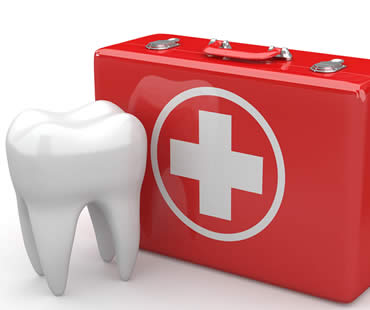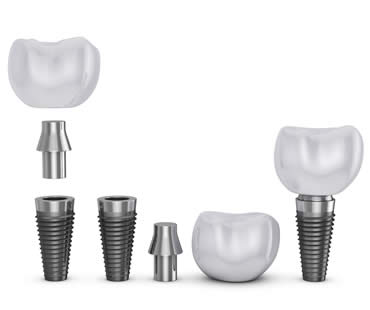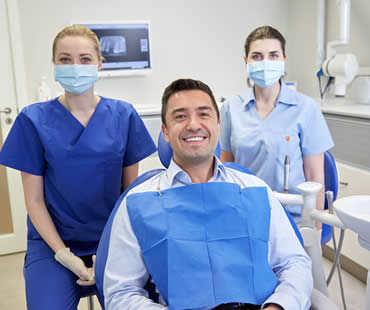
Blog, Dental Information, Dental Topics 2
Problems with your mouth or teeth can occur suddenly. You might be injured playing a sport, eating, or even just while doing a seemingly harmless activity. You should know what types of dental problems are considered emergencies, and what to do while waiting to see your dentist. Quick action can make a big difference in saving a tooth, or limiting damage to your mouth or face.
What is considered an emergency?
Not every dental problem must be treated as an emergency, but some do require professional treatment as soon as possible. This includes a broken or knocked out tooth, lost crowns and fillings, severe toothache, infection, and injuries to the soft tissues of your mouth.
What should I do?
See your dentist as soon as possible to treat the problem and prevent further damage. Here are some steps to take if you experience any of the following common dental emergencies:
- Severe toothache – rinse your mouth with warm water and floss to remove trapped food.
- Swelling – apply a cold compress on the outside of the swollen area. Do not place any painkiller or aspirin against your gums, because it can burn your gum tissue.
- Chipped or broken tooth – if possible, save the piece that has broken off. Rinse both the piece and your mouth with warm water. If it is bleeding, hold gauze on the area. Apply a cold compress to relieve pain and reduce swelling.
- Lost filling – apply dental cement from your drugstore to fill the hollow area until you can see your dentist. Or, try placing a bit of sugarless gum into the area.
- Lost crown –try to replace the crown on your tooth and hold it in place temporarily with dental cement, denture adhesive, or toothpaste.
- Abscess – infections in your mouth can become abscessed, which is a serious condition. Rinse with warm salt water and see your dentist immediately.
- Soft tissue injuries – treat damage to your gums, cheeks, tongue and lips by rinsing with warm salty water. Hold gauze to the specific area to control bleeding, and hold a cold pack to the external area.
Schedule your appointment at our Gaithersburg dental office

Blog, Dental Topics 2, Implant Dentistry
Dental implants are artificial teeth that mimic your natural tooth roots and are placed directly into your jawbone to provide optimal support for dental crowns, bridges and removable prosthodontics such as dentures. If you are considering dental implant therapy, please use the following guide to answer some of your questions.
- Am I a candidate for dental implant treatment? Dental implants can be used in healthy patients whose jawbones have completed growing and who have sufficient quality and quantity of jawbone to have a healthy implantation.
- Is dental implant treatment safe? Dentists agree that in healthy patients who are good candidates for the procedure, dental implants are low-risk.
- Will I be in a lot of pain during dental implant surgery? Dental implant surgery is typically performed as an outpatient procedure in your dentist’s office under local anesthesia.
- Does it take a long time to undergo the procedure? Treatment can generally be performed in under an hour, depending on the number of implants required.
- Is recovery painful? Healing from dental implant surgery is typically quick and easy for most healthy people. Any lingering pain can be treated with over-the-counter pain relievers.
- When will I get my new teeth? Implants must fuse to the bone in a process called ossification, a process that can take up to six months. In most cases, temporary teeth will be in place during this time period.
- How do I care for my dental implants? You will take care of your implants in the same way you would care for your natural teeth. Brush twice a day or after meals, especially before bedtime. Floss daily and continue to maintain regular dental appointments for checkups and preventative care.
- How long do dental implants last? Dental implants can last for twenty or thirty years if you care for them properly.
Our dental office is located in Gaithersburg

Blog, Dental Topics 2, Root Canal Treatment
A tooth that has been damaged by decay or trauma may need endodontic treatment, also called root canal therapy, in order to save the tooth. Although it may sound like a scary procedure, advances in dentistry have made it a much less painful or upsetting process than it used to be. This treatment is worth it to restore your smile as naturally as possible.
How do you know you might need endodontics? You may experience pain in the tooth, sensitivity to hot or cold foods or beverages, or swelling in the area. Severe cases may have a discharge of pus near the tooth. However, not all cases of a badly damaged tooth result in noticeable symptoms. That’s one reason it’s important to maintain regular checkups with your dentist, who will pick up on problems with a tooth that you may not realize is damaged. Examination and testing such as X-rays can help diagnose a tooth that is in dire need of repair.
When possible, dentists strive to save your real tooth. Sometimes the best way to do that is through root canal therapy, which involves removing the damaged tooth pulp from the interior of the tooth. Using local anesthesia to make you comfortable, the dentist or endodontist uses special tools to enter the root canal, remove the pulp, and clean the area thoroughly. Once the tooth is ready, a crown is usually placed on top of the existing tooth to protect it from future damage and to complete the process. Sometimes antibiotics are prescribed if an infection was present to help ensure that you are in the best of health.
Endodontic treatment is often compared by patients to simply getting a regular tooth filling. The procedure is usually completed in one office visit and it won’t be long before you are back to your normal routine, with a fully restored natural tooth in your smile.
If you live in the Gaithersburg area contact us today

Blog, Dental Topics 2, Family Dentistry
When you’re talking about the oral health of yourself and your family, there is no excuse for neglecting regular dental care. There are various kinds of dentists and specialists, but if you need general dental treatment, a family dentist is a great choice.
Family dentists treat common dental problems and provide maintenance care. Visiting a family dentist is the first line of defense against oral health problems. In addition to regular checkups and cleanings, you will learn preventative techniques to help you avoid issues. If the dentist diagnoses a problem and you need further treatment, a specialist in that area may be recommended to provide additional specialized care.
It is important to find the right family dentist for your needs. Look for advertisements for dentists in your area, and ask friends and family for recommendations. Visit the dental office before finalizing your selection so that you can meet the staff, see the facility and equipment, and learn more about the practice. You should feel comfortable and confident in the office policies and staff, since you are likely establishing a healthcare relationship to last for years.
Also ask about the dentist’s qualifications and experience. Make sure that the services you are interested in are offered, and that the dentist works with specialists to get you the proper treatment for those that are not offered. It is ideal to visit the dentist for minor treatment such as a professional cleaning before switching the whole family to the practice. That way you can see first-hand if the dentist meets your expectations. You may also want to schedule an appointment for your children to ensure the whole family is comfortable.
Once you and your family are confident that the family dentist is right for all of you, switch everyone to the practice and then follow up on regular dental care for the whole family.
If you need a dentist in Gaithersburg contact us today

Blog, Dental Information, Dental Topics 3
Everyone wants to attain a brilliant, white smile. Modern dentistry can help you achieve this goal with Invisalign teeth whitening or cosmetic enhancements such as veneers or porcelain crowns. Brushing and flossing will help you keep your smile in prime condition. Your diet can impact your teeth as well. Certain foods and beverages can darken your teeth, including:
• Tea Time
Considered a healthy beverage, tea may not keep your teeth white. In fact, black tea can leave more stains than coffee.
• Saucy Saucy
Yummy extras like soy sauce, tomato sauce, and curry sauce may taste delicious, but they have significant potential in the stain department. Choose lighter cream sauces or brush right away to limit issues.
• Sports Power
Highly acidic beverages, like sports or energy drinks, erode tooth enamel and make teeth more susceptible to stains. Try water when you exercise as a safer choice for your smile.
• A Little Wine
If a drink will stain your linens, it can also alter the appearance of your pearly whites, so limiting your intake of wine can protect your smile.
• Berry Good
Though blackberries, cherries, and blueberries are great for your body, the deeply pigmented molecules in these fruits can stick to enamel and cause discoloration. Pies and juices containing these foods can also stain teeth.
• Bubbling Over
Frequently a cause of stains, sodas and other carbonated drinks have acid and chromogens, which can lead to serious stains. Even lighter colored drinks have enough acid to allow staining from other foods and beverages.
Our dental office is located in Gaithersburg

Blog, Cosmetic Dentistry, Dental Topics 3
Most people have things about their smiles they’d like to fix. Maybe the things are minor or perhaps they are major, but most of them can be addressed with some form of cosmetic dentistry. You may have been unhappy for a while with the smile you see in the mirror, but just haven’t felt the necessary impetus to schedule an appointment with a cosmetic dentist.
To get that jump start toward your dental treatment, look ahead in your life. Maybe you have a class reunion coming up, or maybe a friend’s wedding. Perhaps there’s a job interview, first date or anniversary approaching. These special occasions are all excellent reasons to turn to cosmetic dentistry treatments. Here are some of the most common procedures that could be used to transform your smile.
- Teeth whitening – perhaps the most popular and common cosmetic dentistry procedure, it utilizes light-activated bleaching chemicals that can lighten natural teeth and remove stains and discoloration.
- Dental veneers – very thin, wafer-shaped shells crafted out of porcelain or another material that are bonded onto the natural surface of the tooth. Sometimes a thin layer of the natural tooth enamel must be removed in order to accommodate the application of the veneer.
- Dental bonding – composite resin mixed to match the color of your tooth and then molded by hand onto the tooth’s surface to create the illusion of a complete natural tooth.
- Dental crowns – restorative dental therapy that protects and preserves a natural tooth that has had a root canal treatment.
- Enameloplasty – the correction of malformations of a natural tooth through hand-shaping. This is also the name for the removal of the tooth’s surface required for most types of dental veneers.
All of these cosmetic treatments will transform your smile for that special occasion. Get the bright, straight, white smile you want people to remember with the help of a little cosmetic dentistry.
If you live in the Gaithersburg area contact us today







